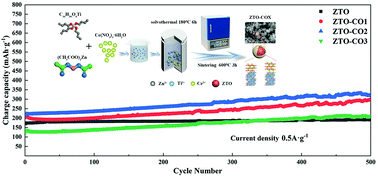High-performance Li-ion battery driven by a hybrid Li storage mechanism in a three-dimensional architectured ZnTiO3–CeO2 microsphere anode†
Abstract
ZnTiO3 and ZnTiO3–CeO2 microspheres with particle sizes of about 100–300 nm were synthesized for the first time by a simple solvothermal process followed by calcination. The results indicate that CeO2 modification does not alter the morphology of the microspheres. ZnTiO3–CeO2 (0, 3, 6, and 9 wt%) show an initial charge (discharge) capacity of 171.01 (253.2), 204.6 (507.5), 213.4 (451.6) and 126.2 (367.2) mA h g−1 at 500 mA g−1, respectively. After 500 cycles, the corresponding charge (discharge) capacities were 191.1 (192.3), 298.7 (300.3), 322.4 (328.5) and 211.2 (212.3) mA h g−1, respectively. Obviously, the charge (discharge) capacities of the ZnTiO3–CeO2 composites are superior to those of pristine ZTO, which demonstrates that the Li storage performance of the CeO2-modified ZTO electrodes is improved. The CeO2 shell provides a good electronic contact between ZnTiO3 and CeO2, decreasing charge transfer resistance and facilitating the charge transportation of the ZnTiO3–CeO2 composite. In addition, the formed phase interface between CeO2 and ZnTiO3 may provide more active sites for electrochemical reactions, improving the reversibility of Li-ion intercalation and decreasing the electrochemical polarization during cycling, especially at high current densities. Therefore, such ZnTiO3–CeO2 microspheres can be regarded as hopeful candidates for anode materials for Li-ion batteries.



 Please wait while we load your content...
Please wait while we load your content...